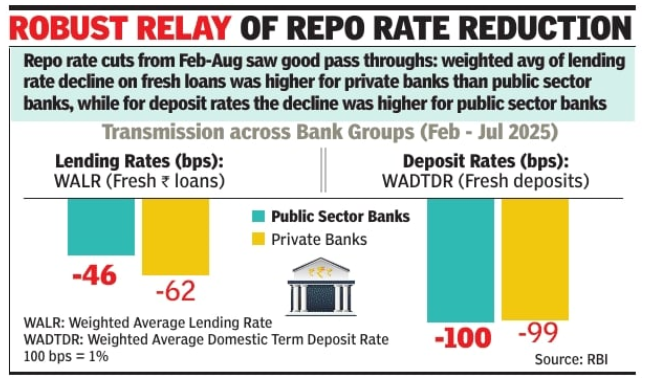Stage set for stronger growth, consumption in H2 FY25: RBI
MUMBAI: GST reforms, coupled with a five-quarter high GDP growth, have positioned the Indian economy for a sustained period of expansion, RBI’s ‘State of the Economy’ report released on Wednesday showed. The report presents an optimistic outlook for second half (H2) of the fiscal year, suggesting that robust domestic drivers are set to overcome global uncertainties, including new US trade tariffs.According to the report, the stage is set for sustained pick up in consumption demand in H2, and potentially for a virtuous cycle of higher investment and stronger growth impulses, overcoming persistent global uncertainties. The drivers for this virtuous cycle are the ‘robust’ pass through of the 100 basis point rate cut between February and August. This, coupled with cut in income tax and simplification of GST are expected to revive growth impulses.

The report highlights that the recently-implemented GST reforms are a key catalyst for future growth. “The landmark GST reforms should progressively result in a sustained positive impact through significant gains in ease of doing business, lower retail prices and strengthening of consumption growth drivers”. This aligns with the report’s overall positive projections for the coming months.According to the report, the Indian economy’s current strength is fundamentally domestic. In Q1 2025-26, the economy achieved a five-quarter high in growth, propelled by strong consumption and fixed investment. The report notes a remarkable resilience in domestic demand, with rural consumption remaining robust and a broad-based expansion across sectors. The manufacturing and services sectors, in particular, saw significant growth, with their respective PMIs reaching an 18-year and a decade high. Going ahead, favourable monsoon conditions and robust kharif sowing are expected to support the agriculture sector and help contain food prices.Despite this internal strength, the report acknowledges significant external risks. “Global uncertainty remained elevated in the wake of imposition of US trade tariffs on major trading partners and renewed concerns over fiscal health of advanced economies”. The imposition of a 50% US import tariff on Indian exports led to a temporary decline in equity markets and contributed to a depreciation of the Indian rupee against the US dollar. However, robust domestic institutional buying successfully offset foreign portfolio investor outflows, showcasing the economy’s ability to absorb external shocks.



